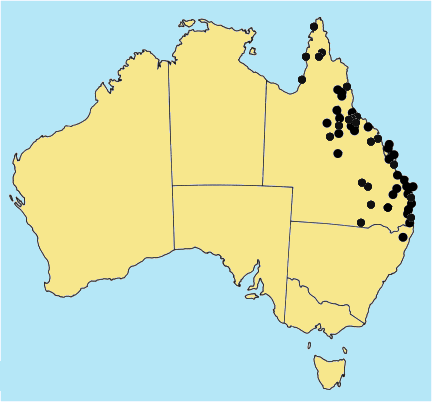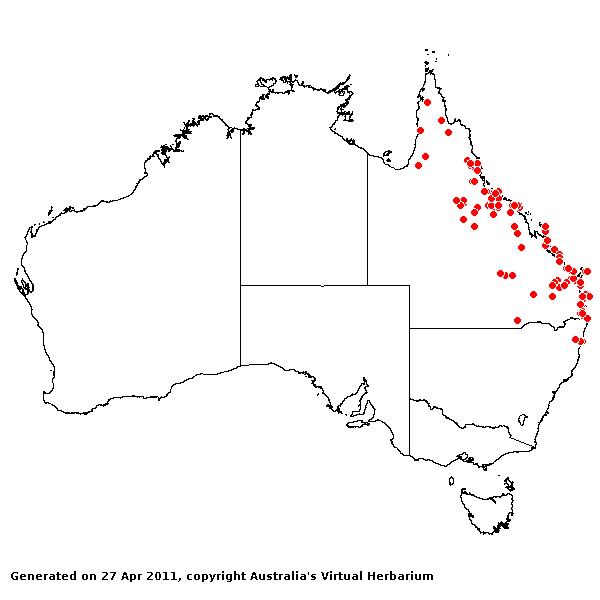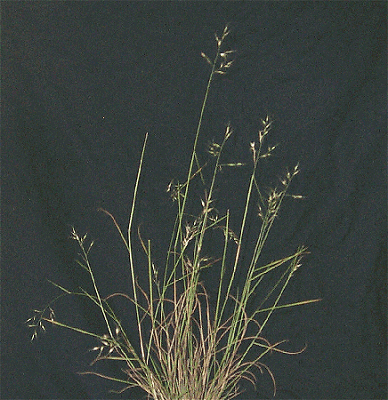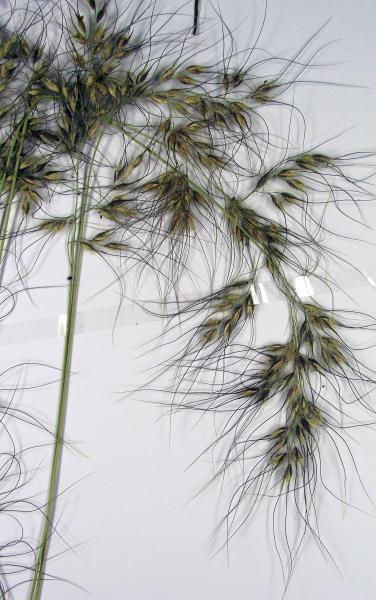Eriachne rara R. Br. Prodr. 183
(1810).
Classification. (GPWG 2001) : Subfamily
Micrairoideae. Eriachneae.
Type of Basionym or
Protologue Information: Australia, Shoalwater Bay: Brown 6261 (BM holo, B, BR, CANB, E, K).
Key references
(books and floras): [1810]. R.Brown, Prodromus (183), [1878] G.Bentham,
Flora Australiensis 7 (628), [2002] D.Sharp & B.K.Simon, AusGrass,
Grasses of Australia, [2008] S.W.L.Jacobs, R.D.B.Walley &
D.J.B.Wheeler, Grasses of New South Wales (261).
Illustrations:
[2008] S.W.L.Jacobs, R.D.B.Whalley & D.J.B.Wheeler, Grasses of New South
Wales, 4th edn (262).
Habit.
Perennial. Culms 16–75 cm tall. Mid-culm nodes bearded. Lateral branches simple
or sparsely branched. Ligule a fringe of hairs, 0.5 mm long. Leaf-blades
conduplicate or involute, 4–20 cm long, 1–3 mm wide. Leaf-blade surface
scaberulous, indumented.
Inflorescence.
Inflorescence compound, a panicle. Panicle elliptic or oblong, 3–10 cm long,
0.5–5 cm wide.
Spikelets.
Spikelets pedicelled. Fertile spikelets 2-flowered, both fertile, comprising 2
fertile floret(s), without rachilla extension, ovate, laterally compressed, 5–9
mm long.
Glumes.
Glumes similar, thinner than fertile lemma. Lower glume ovate, membranous,
without keels, 9–11 -nerved. Lower glume surface glabrous or indumented. Lower
glume apex muticous or awned. Upper glume ovate, 5–9 mm long, membranous,
without keels, 9–11 -nerved. Upper glume surface smooth, glabrous or
indumented. Upper glume apex muticous or awned.
Florets.
Fertile lemma 3–5.5 mm long, without keel, 5 -nerved. Lemma surface indumented.
Lemma apex awned, 1 -awned. Median (principal) awn 12–30 mm long overall. Palea
apex erose or dentate, awned (2). Grain 1.8–3 mm long.
Continental
Distribution: Australasia.
Australian
Distribution: Queensland, New South Wales.
Queensland:
Burke, Burnett, Cook, Darling Downs, Leichhardt, Moreton, North Kennedy, Port
Curtis, Wide Bay, South Kennedy, Maranoa. New South Wales: North Coast.
Notes.
The chief features of this species are dense indumentum, loose often tubercled
hairy panicle, sparsely hairy long-acuminate often aristulate glumes, short
(relative to glumes) often red florets with appressed lemma and palea,
relatively long callus, cartilaginous awned finely nerved lemmas obscured by
simple hairs, and beaked bifid palea. The body of the lemma lacks the submarginal
grooves of many other species, but there may be a depression or short groove on
both sides of the awn at its base. Eriachne rara has similarities with E.
armitii and E. squarrosa, but there are differences in habit,
panicle structure, and in the dimensions and indumentum of the spikelet.
Endemic.
Qld and N.S.W. between 20ºS and 30ºS, predominantly on islands and coastal
mainland. Deep or shallow, sandy, sometimes gritty or stony, soils in
association with sandstone, laterite or granite; recorded also on
"wallum" slopes, hillslopes and ridges, Melaleuca swamps, and
seasonal water channels. Flowers and fruits chiefly Feb.-May (late-summer to
autumn), extending to Sept. (winter and early-spring).






